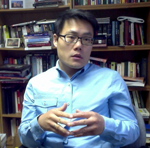Due to the racial and religious homogeneity of my institution, which is predominantly white and Christian (the University of Findlay, in rural Ohio), I have unconsciously focused on issues of greatest concern to my students, especially in the beginning of my teaching career – and this has not included race. This is ironic, for I myself am a native born Korean transplanted to the American Midwest. It was not until I taught my Islam course in 2013 that I found this approach deficient. That semester I had a hands-on experience of the positive role of racial diversity in the classroom. My students and I learned that race in the classroom is more than skin color. It is a powerful instrument that can expose the learner to an understanding of how they are viewed by others and engage them in dialogue with people of conflicting views, and eventually foster civility.
My Islamic Tradition course is an upper-level course. Like my other courses, it normally does not have students of color. However, spring 2013 was different. For whatever reason, more international students enrolled. In addition to white Americans, I had several Saudi Arabian students, an Indian American, and a Korean. This racial diversity made me extremely uncomfortable because, after the first class, I immediately realized that I had to deal with not only three different races and an additional religion but also a whole set of issues touching on culture, economy, politics and even the validity of the academic study of religion itself. The American students were not just “white” -- they included an atheist, a future pastor, a feminist, and a Desert Storm veteran. The Saudi Arabians were not just Arabs -- they brought both the Sunni and the Shia socio-cultural and political complexity to the class. The South Asian Muslim was a second generation Indian American woman who consistently challenged Islamic orthodoxy. And the Korean student was a Christian formed in a Confucian mindset.
 In this unusually diverse class (for the University of Findlay) we experienced many emotional moments, because every one of us felt pressure. While the Sunni Saudi Arabian students were concerned to present the correct understanding of Islam and raised objections on every issue, the white American students were reluctant to actively participate in class discussion because they were afraid of offending the Muslims in the room. Occasionally they showed symptoms of “the white man’s burden,” although it was never very explicit. The Indian student had a hard time accepting the value of the academic study of religion, challenging almost every reading assignment. In the meantime, the Korean and the Shia students were frustrated by their marginalized status in the class. In particular, the Shia students, who were always quiet in class, would stop by my office before or after class to express the feelings and thoughts that they were not comfortable sharing in front of the Sunni students. Like the Americans, they didn’t want to offend the Sunni students, or be offended by them. Pedagogically, I was unprepared for this diversity, and I could not have anticipated how uncontrollable this intellectual and emotional challenge would be.
In this unusually diverse class (for the University of Findlay) we experienced many emotional moments, because every one of us felt pressure. While the Sunni Saudi Arabian students were concerned to present the correct understanding of Islam and raised objections on every issue, the white American students were reluctant to actively participate in class discussion because they were afraid of offending the Muslims in the room. Occasionally they showed symptoms of “the white man’s burden,” although it was never very explicit. The Indian student had a hard time accepting the value of the academic study of religion, challenging almost every reading assignment. In the meantime, the Korean and the Shia students were frustrated by their marginalized status in the class. In particular, the Shia students, who were always quiet in class, would stop by my office before or after class to express the feelings and thoughts that they were not comfortable sharing in front of the Sunni students. Like the Americans, they didn’t want to offend the Sunni students, or be offended by them. Pedagogically, I was unprepared for this diversity, and I could not have anticipated how uncontrollable this intellectual and emotional challenge would be.
 However, this class ended up being my best teaching experience to date. I received very positive feedback from the students. Since then, I have thought about what I did as an instructor and what my students learned throughout the semester. It was not really about teaching content knowledge. When I recognized the complexity caused by the racial and religious diversity in the room, I realized that I would need to shift my focus from specific content knowledge to the value of encounter and dialogue. Following the suggestions from my Wabash colleagues and mentors, I clarified my intentions and goals for the academic study of religion, I set ground rules for discussion, and I worked hard to create a bond with each student. What made this class successful was the power of diversity.
However, this class ended up being my best teaching experience to date. I received very positive feedback from the students. Since then, I have thought about what I did as an instructor and what my students learned throughout the semester. It was not really about teaching content knowledge. When I recognized the complexity caused by the racial and religious diversity in the room, I realized that I would need to shift my focus from specific content knowledge to the value of encounter and dialogue. Following the suggestions from my Wabash colleagues and mentors, I clarified my intentions and goals for the academic study of religion, I set ground rules for discussion, and I worked hard to create a bond with each student. What made this class successful was the power of diversity.
About Song-Chong Lee
Associate Professor of Religious Studies and Philosophy University of Findlay
